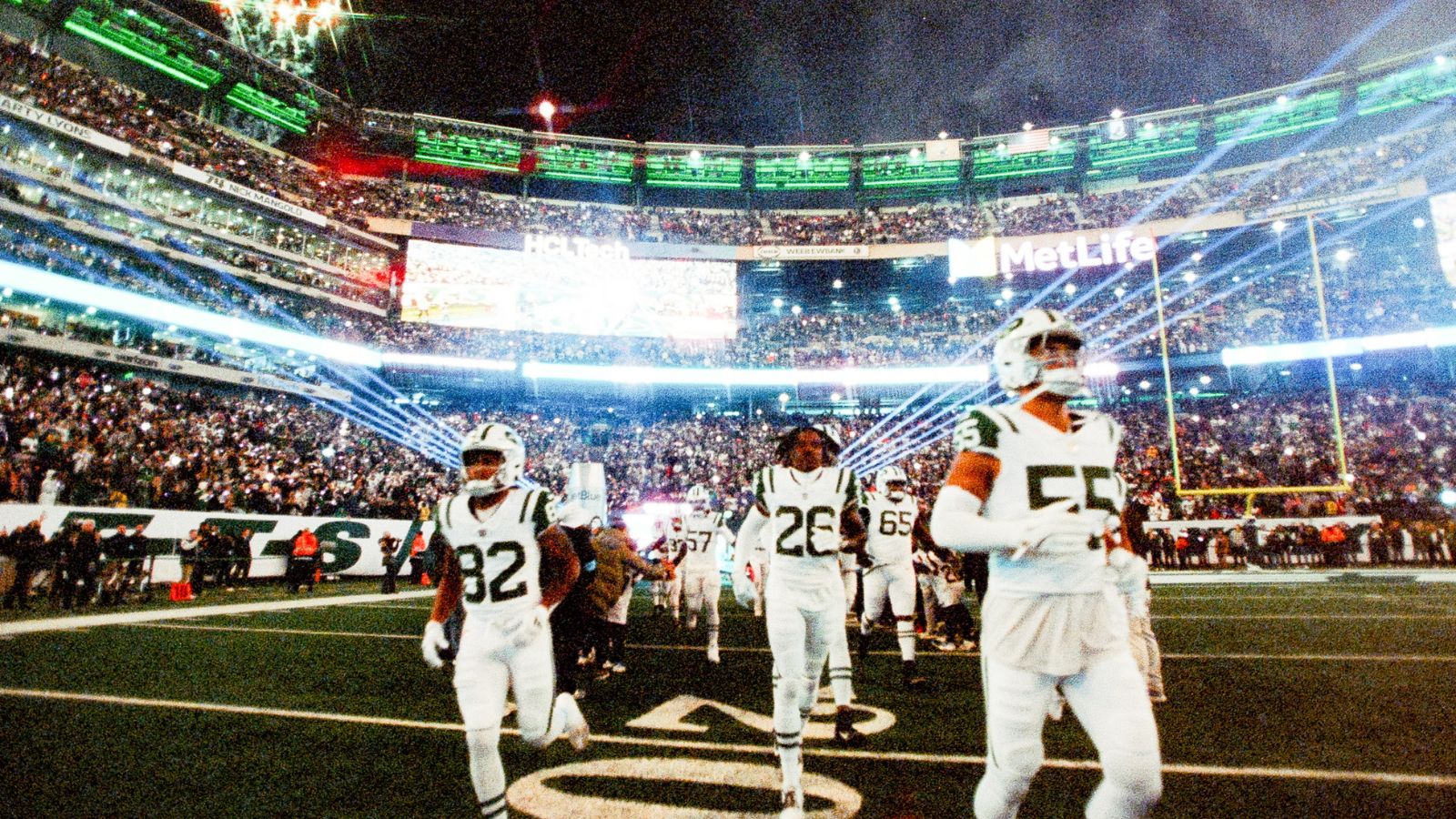Black Friday 2025 has landed at Analogue Wonderland, bringing some of our biggest film photography deals of the year - from discounted film and cameras to money-saving WonderLab processing offers, exclusive bundles, and festive specials available for a limited time only. Grab a great deal while stocks last!
Recent posts
Shop the article

Processing Film in an NFL Stadium: WonderLab Touchdown
By Amy Farrer
When we received a call from Miles (Expired Film Club) asking if someone from our Analogue WonderLab could fly to New York to develop film for him live on site for the New York Jets, we couldn’t quite believe what we were hearing! These kinds of opportunities don’t come about often. So, off we sent our talented Lab Technician, Will McMahon, with Miles to give it a good go 💪 If you’re curious about what it’s like to develop and scan film backstage at MetLife Stadium for an NFL team (niche, we know), here’s Will’s firsthand account of the adventure.
Meet Miles aka Expired Film Club
If you haven’t yet caught onto the social media sensation that is Expired Film Club, here’s a little bit of background information. Our friend Miles Myerscough-Harris has been living his best life recently, capturing some of the world’s biggest sporting events on film. From football and snooker to sailing and rugby, Miles has almost done it all - and time was the turn of an NFL match (American football)!
Back in June, we were fortunate to have Miles join us for our monthly Club AW Click & Chat, where he shared stories of his journey shooting with expired film, capturing live gigs, and now making a mark in the world of sports photography on film. If you’re a fan of his work, don’t miss the chance to watch it below.
So, the plan was simple: fly to New York, develop and scan five rolls of colour film in just a few hours, and get the shots ready for Miles to post in collaboration with the New York Jets that very night. Easy, right? Not exactly - sounds stressful! 😅 (But maybe not the most stressful trip any of us have ever been on...) But we were all very excited about the spectacle, especially Miles, as he shared the plans with his followers on Instagram.

New York, here we come! ✈️ Will and Miles were in good spirits as they embarked on their analogue adventure.
Expectations vs. Reality
Now, the first immediate observation by Will was his makeshift lab: the MetLife Stadium toilets behind the press conference room. How glamorous! 😂 Shoutout to Miles for adding a personal touch with a custom sign: ‘Will’s Special Place: Film Developing Co’ - just to make him feel a little more at home.
Expectation #1: Access to a standard tap with hot and cold water
Will anticipated a regular tap with adjustable hot and cold water for the development process. Instead, he found himself working with a motion-sensor tap in the stadium toilets, set at a fixed temperature. The workaround? Microwaving water to reach the correct temperature, which was a bit of an unexpected hassle! But hey, he can probably claim he’s the first to develop film in MetLife Stadium’s bathrooms so there’s a silver lining there.
Miles had faced a similar setup when he shot the World Snooker Championship Final on Ilford Delta 3200 and developed the film backstage at the Crucible. But there’s a key difference: black and white film can be processed with cold water, while colour film (C-41) needs warm water. So although Miles handled similar challenges, it was a little easier with B&W films - though the pressure of simultaneously being a film photographer and film processor was real!
Expectation #2: Being well rested ready for the big day
Now, it’s not that Will isn’t hard working - quite the opposite! But we all know that before a big day, a good night’s sleep is essential. With plenty to prepare for the game, Will and Miles had to be on-site early to set up for their developing, scanning, and posting mission.
Expectation #3: Mistakes would be made
Developing and scanning multiple rolls of film under serious time pressure seemed like a recipe for disaster, and Will was sure something would go wrong. But, against all odds, every roll turned out perfect - mistake-free 😎 It was big smiles all around for both Will and Miles. Seems luck was on his side!
There’s one - not so much a mistake, but a test - worth mentioning. Will tried using a hairdryer to speed up drying the negatives, but when things started getting a little too hot, he quickly abandoned that idea. Melting Miles’s film probably wouldn’t go down well! So, he opted for hang-drying the rolls in the shower instead. A portable film dryer would’ve been ideal, but it’s bulky and pricey, so hardly practical for this international adventure.

Here it is in all its glory: Will’s glamorous make-shift lab! (The MetLife Stadium toilets)
Equipment Used
This entire process would not have gone as smoothly without the right equipment to make everything efficient and travel-friendly. Each piece played a crucial role in making this mobile development and scanning mission possible.
AGO Film Processor: The AGO Film Processor was the backbone of the operation, sparing Will from many potential setbacks. With no access to an ideal water temperature, the AGO stepped in perfectly, maintaining the necessary control over temperature, timing, and agitation. This portable powerhouse is a must for developing colour films on the go, providing the precision needed for consistent results.
CineStill Cs41 Powder Kit: These were the essential chemicals for the job, providing the developer and bleach/fix packs that Will used throughout the process. Known for being user-friendly and reliable, the Cs41 kit simplified the chemical side of film development.
VALOI 360 Enthusiast Kit: To capture high-quality scans, Will relied on the VALOI 360 Enthusiast Kit, which includes a 35mm film holder and the CineStill CS-LITE for optimal scanning results. Despite using a makeshift scanning setup - ingeniously balanced on a briefcase for the right height - this kit helped Will to deliver impressive scans ready for Miles to post on social media.
Other Equipment: For photographing the negatives as part of the scanning process, Will used his Nikon D850 DSLR, which delivered the high resolution needed for detailed scans. The rest of the setup included the usual development essentials like graduated cylinders, film drying clips, and reels, ensuring a familiar workflow despite being on the road.

The scanning setup: laptop, Valoi 360 Enthusiast Kit, and Nikon D850 DSLR camera.
Developing Film at Sporting Events Now vs. Before
Now, you might be thinking, “Didn’t press photographers do this all the time back in the day?” That’s true, but they didn’t have the added pressure of having to “go viral” on social media! For Miles, being one of the few film photographers surrounded by a sea of digital cameras definitely turns some heads.
But why choose the challenge of shooting film in a digitally dominated world? Maybe because it’s deeply rewarding, brings excitement in anticipating the results, and often surprises people who didn’t realise film photography is still a popular choice. And the evidence of that is the huge success of Miles’ platform as Expired Film Club!
Up until the late 1980s, film cameras were the only option, meaning photographers were highly attuned to the challenges of shooting and developing analogue photos - especially during fast-paced events like sports. Remote photographers faced unique obstacles, often needing quick access to lab processing or setting up makeshift darkrooms at venues or in hotel rooms. Photographer Chris Pietsch shared how innovations like the Leafax scanner allowed him to digitise negatives, and fax-like machines were used to transmit these images to the press, bringing breaking sports moments to the public. It's remarkable to see just how far this process has evolved since then.

Two vintage press photo transmission devices: the AP Leafax 35 (left) and the UPI (United Press International) machine (right), used for sending images over phone lines in the pre-digital era.
The Results!
With Will ready to tackle Miles’ film from the first half of the New York Jets vs. Buffalo Bills game, he impressively developed and scanned five rolls of colour film within just three hours - allowing Miles to share highlights on social media before the game even ended. Incredible stuff! 🤯 Throughout the night, Miles shot some of his go-to colour emulsions: Kodak Portra 800, CineStill 800T, and Flic Film Aurora 800. And, true to his style, he couldn’t resist adding an expired roll of Kodak Royal Gold into the mix.
Here are just a few of the incredible shots Miles captured with his trusty Canon F1- check out his Instagram post to see even more!

Here they come! The New York Jets taking the field in their classic throwback kit. That CineStill 800T paired with a star filter is absolutely popping!

The detail and emotion in this shot of Sam Eguavoen is just incredible!

Tyler Conklin, #83, makes his entrance to roaring fans at MetLife Stadium.
While he was there, Will couldn’t resist grabbing the opportunity to capture a few shots himself and give Miles a little challenge! These images were taken on his Nikon F4 with an 80-200mm f/4.5 lens using Lomography 800 35mm film.

And we have contact! There’s quarterback Aaron Rogers handling the ball.

Miles doing his thing. 🙌
What’s Next for the International WonderLab?
Though the experience lasted just 25 hours, Will had a fantastic time! Not a sports fan by nature, he was still captivated by the game’s spectacle: automatic t-shirt cannons, fireworks, light shows, and music - a lively contrast to football matches in the UK! But most importantly, the task was a big success, with smiles all around - especially from Miles.
Will also came away with some valuable insights, setting us up for an even better experience next time. So, will there be a next time? Well, we’d love to do it again! We’re confident that someone else amongst our talented in-house lab team will be eager to take on this challenge. If you’re a sports or event film photographer - or know someone interested in hands-on support from one of our Lab Technicians - reach out to us! Who knows where we could be flying off to next. 👀✈️
(You can read about when Miles took Paul to the rugby here!)
Ready to dive in?
Keep Reading
View all
Christmas 2025: Shipping & Opening Hours
Christmas 2025 is fast approaching! To make sure your analogue goodies arrive in time, take note of our last shipping dates, plus opening and operating hours over the festive season. We've got everything you need to gift the magic of film photography this Christmas!

Film Photography Christmas Gift Guide 2025: Analogue Wonderland
Capture the magic of Christmas with film - no filters needed. Our 2025 Film Photography Christmas Gift Guide 2025 is packed with thoughtful presents for every type of shooter, from curious beginners to seasoned photographers. Discover film stocks, cameras, and creative accessories that will make this festive season truly memorable.
Subscribe to our newsletter 💌
Sign up for our newsletter to stay up to date on film photography news, sales and events:
Free Tracked Shipping
On all UK orders over £50
Passion For Film
An unbeatable range and an on-site lab
Our Customers Trust Us
Thousands of independent 5* reviews
All Deliveries are Carbon Neutral
Independently audited and verified by Planet
- Opens in a new window.







